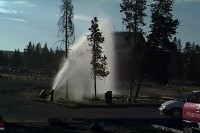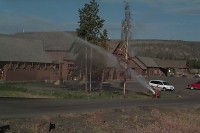The name of the most famous geyser of its day, Geysir at Haukadulur in Iceland, ended up becoming the generic term in many languages for all erupting, boiling hot springs— the word "geyser". I propose that something similar be done to identify and distinguish artificial geysers, or erupting wells, from their natural counterparts.
Most of these features are out of the way, neglected, or at best, local curiosities. But there is one with delusions of grandeur, and I propose that it's name become the generic term for all of these features.
Throughout the Western U.S. are a number of these features. They can be the only feature, as at Lakeview, Ore., or the dominant feature with other, natural springs nearby, as at Green River, Utah., or one feature among many natural features, including natural geysers, as was the case at Steamboat Springs and Beowawe, Nev. The driving mechanism can either be heat and boiling temperatures, as at the Nevada sites, or gases in the water, as in Utah.
Located in Northern California is a tourist trap based on an eruptive feature, the so-called "Old Faithful Geyser of Calistoga." Billed as a true geyser, it is the last of what seems to be several erupting wells in the Calistoga area in the early 20th century. Early 20th Century postcards make reference to a whole host of them, including one card that shows two features erupting together.This feature should not be compared to Old Faithful Geyser, but the name "the Firehose of Calistoga" just doesn't have the same effect.
But we should give this feature some credit, I've proposed that an erupting artifical features be refered to as "a calistoga". The word has a nice ring to it, and in the realm of true geysers, is otherwise completely meaningless. And because the word has been in use as a placename for over a century, it doesn't have the artificial feel of modern corporate names, or of deliberate attempts to coin a descriptive term.


27 July 1998
About a decade ago, there was even a calistoga in the Old Faithful area. Well, sort of one
If the specifications require that a fire water line be laid
at a depth of six feet to prevent freezing, do so, even if the
ground is so hot that small thermal springs are breaking out in
the trench. This is what happened when a new fire line was placed
along the service road behind the Lower Hamilton's store around 1978-1979.
Immediately afterwards several hydrants behind the
store along the service road were found to be so hot that they were unusable for emergencies. Some still
are.Around some of the hydrants, the discoloration of thermal alteration
of soil and rock, normally only visible around natural thermal features,
are easily visible.
These photographs show another one of the results that were a common sight in the last few years of the 1990s — pressure build-up that several times a week had to be released by NPS maintenance. After a few years, like most thermal features, it went dormant as the heat and pressure subsided.
There might be some who object that the hydrant wasn't a true calistoga, since eruptions had to be initiated by someone using a wrench to open a valve. But many other calistogas are subject to human control (most notable, Lady Knox Geyser in New Zealand), and that is hot water being thrown in those photos.
[Parts of this posting appeared on 2002-Apr-19 in an earlier version of this weblog.]


